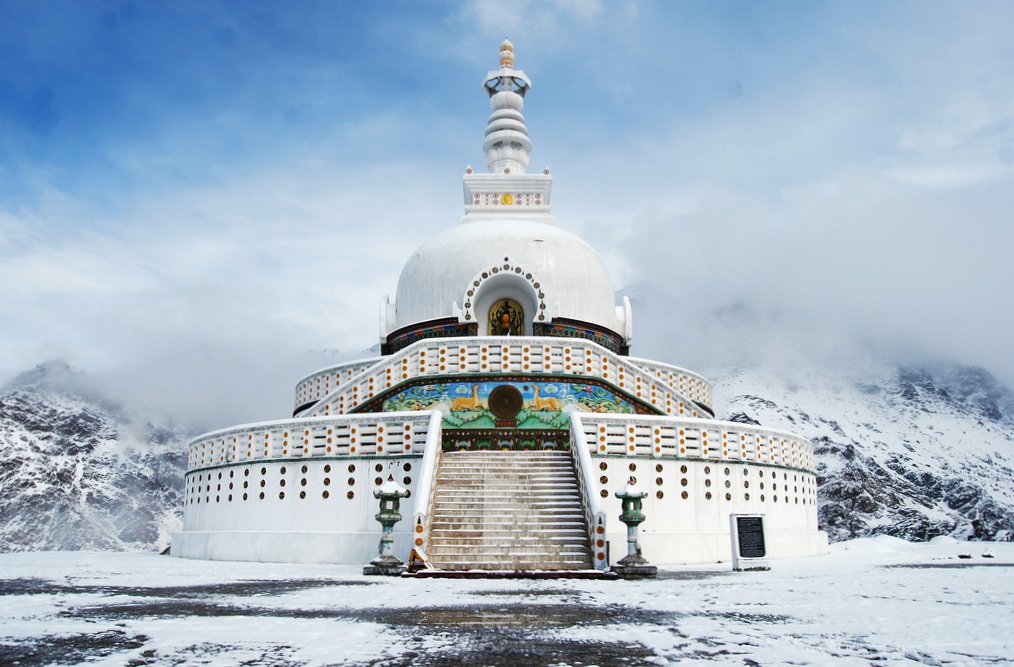Peaceful Buddhist monument symbolizing harmony in Ladakh's majestic landscape





Shanti Stupa in Leh, Ladakh, represents a profound testament to peace and spiritual collaboration between India and Japan. Its creation emerged from a visionary mission by Nichidatsu Fujii, a Japanese Buddhist monk dedicated to constructing peace pagodas worldwide. The project gained significant momentum through the support of Kushok Bakula Rinpoche, a revered Buddhist monk and statesman who recognized the stupa's potential to symbolize hope in a region marked by geopolitical tensions.
Initiated in 1983 and formally inaugurated in 1991 by the 14th Dalai Lama, Tenzin Gyatso, the stupa embodies a powerful narrative of cross-cultural understanding. The collaborative effort between Japanese and Indian governments, coupled with the local Buddhist community's involvement, transformed this architectural marvel into a beacon of international harmony. Its construction commemorated 2,500 years of Buddhism, capturing the spiritual journey from Buddha's birth to enlightenment through intricate architectural elements and symbolic design.
The stupa's architectural design is a masterpiece of spiritual symbolism. A two-level structure featuring a central golden Buddha image and meticulously carved scenes depicting the Buddha's life, it stands as a white monument against Ladakh's breathtaking landscape. Its design reflects not just architectural brilliance but also the profound philosophical principles of peace and non-violence. The white exterior serves as a metaphorical canvas representing tranquility and spiritual purity.
Geographically positioned in a region historically characterized by military tensions, Shanti Stupa transcends political boundaries. Its strategic location near the borders of India and Pakistan makes its message of peace even more poignant. The stupa represents a deliberate intervention, challenging the narrative of conflict by offering a space of contemplation and spiritual reflection. Its panoramic views of the Leh Valley further emphasize the interconnectedness of humanity and nature.
Beyond its architectural and spiritual significance, Shanti Stupa serves as a critical cultural bridge. It attracts diverse visitors—spiritual seekers, history enthusiasts, and nature lovers—who are drawn to its serene atmosphere and profound symbolism. The collaborative spirit behind its construction highlights the potential for international understanding through shared spiritual and cultural values. Japanese and Indian Buddhist traditions converge in this remarkable monument, demonstrating how cultural exchange can foster mutual respect.
The stupa's significance extends far beyond its physical structure. It represents a living narrative of peaceful coexistence, challenging regional narratives of conflict through its very existence. The involvement of prominent figures like Kushok Bakula Rinpoche and Nichidatsu Fujii underscores the deliberate intention to create a space that transcends political and cultural boundaries. Their vision transformed the stupa from a mere architectural project into a powerful statement about human potential for harmony.
The site's spiritual ambiance invites introspection and meditation. Visitors ascending its steps are not just climbing a monument but embarking on a metaphorical journey of self-discovery. The panoramic mountain views serve as a backdrop to this internal exploration, reinforcing the interconnectedness of individual experience with the broader cosmic landscape. Each step represents a movement towards understanding, peace, and spiritual awakening.
As a testament to cross-cultural collaboration, Shanti Stupa continues to inspire generations. It stands not just as a monument but as a living philosophy—a reminder that peace is achievable through understanding, respect, and shared spiritual values. In an increasingly fragmented world, this remarkable structure in Ladakh offers a powerful alternative narrative, inviting visitors to reimagine human potential beyond the limitations of geopolitical boundaries.
Discover more attractions within 50km that might interest you

Leh, Ladakh
Spiritual Sanctuary Overlooking Leh Valley with Ancient Buddhist Heritage